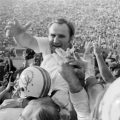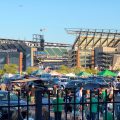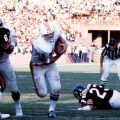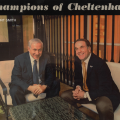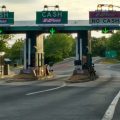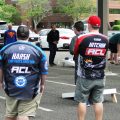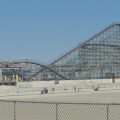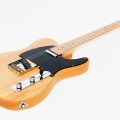Tag Archives: fenway park
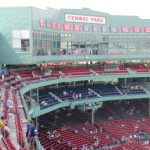
Fenway Park vs. Wrigley Field – Two Ballpark Aficionados Debate
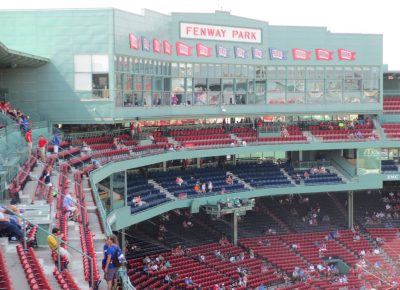
Stadium Journey published the much-anticipated debate between me and Joe Mock – and our locking horns over which of America’s two oldest ballparks is a better place to see a ballgame. I thought we put it together well. Hope you enjoy the read. (Click here to see the PDF from the magazine; click here to visit the excellent Stadium Journey website.)

In this corner, the Green Monster American Leaguer from Boston!
BALLPARK VERSUS BALLPARK
Fenway or Wrigley – Which is the best?
Joe Mock (www.BaseballParks.com) and Kurt Smith (www.BallparkEGuides.com) are webmasters for two of the most popular ballpark-themed websites on the net…and both are foremost authorities on what makes Wrigley Field and Fenway Park special. But which ballpark takes the top spot in the battle of the two classics?
The two disagree on the answer, with Joe preferring Wrigley and Kurt siding with Fenway. Let the debate begin!
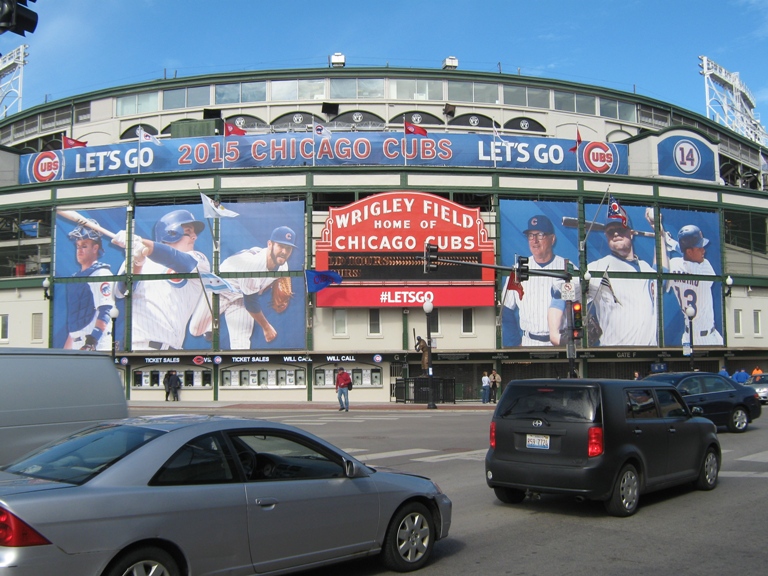
And in this corner, the ivy-covered National Leaguer from Chicago!
Each Ballpark’s Place In History
JOE: When you have two parks that date back over a century, that’s a LOT of history. Wrigley, though, wins in this category, but not by a lot.
Simply standing within the Friendly Confines fills you with a sense of history that can’t be matched by any other facility – of any sport. One reason for this is because of the way the park looks. The stately stands. The bleachers. The ivy. Just everything.
In 2014, I got to cover the 100th birthday of Wrigley for USA Today, and the way the Cubs put on the event showcased that history. While wearing throwback uniforms, they played as the Chicago Whales of the 1914 Federal League. You had no trouble envisioning the Whales playing in that ballpark. And to give the proceedings an extra air of century-long authenticity, the home team blew a lead and lost the game.
From the legendary called shot by Babe Ruth to the tragedy of Steve Bartman to the mind-blowing prowess of Jake Arrieta, Wrigley is history.
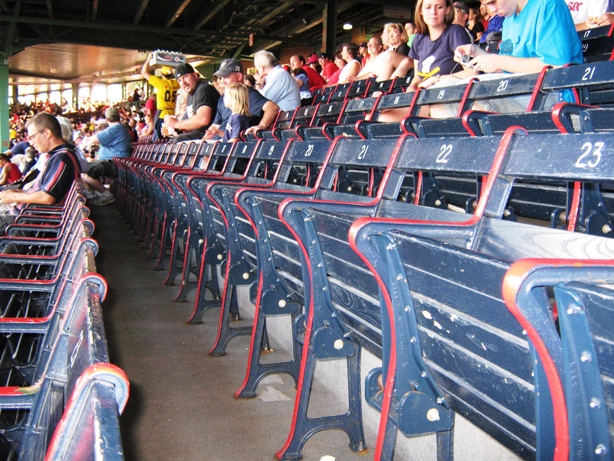
Nothing says “old ballpark” like small, wooden grandstand seats.
KURT: I agree with Joe that both Fenway and Wrigley can’t help but feature history as the backbone of their greatness…Babe Ruth (supposedly) called his shot at Wrigley and pitched at Fenway…but I disagree on the key point Joe makes about the ballparks’ look, at least now.
The Red Sox and Cubs have both recently renovated their classic ball yards, but the Red Sox enhanced the historic aspects of their ballpark, while the Cubs disrupted it. The Red Sox placed seats atop of the Green Monster and closed off Yawkey Way during games to create a great pre-game atmosphere, and the new video boards in Fenway actually look like the hand-operated classic in left field and blend in very nicely.
By contrast, the Cubs placed a huge, high-definition video board in left field that is anything but historic…and many fans agree looks completely out of place. In doing so the Cubs not only blocked the view from the Waveland Avenue rooftops, but also made the hand operated out-of-town scoreboard in center field look completely unnecessary. The rooftops and scoreboard, to these eyes anyway, were as iconic as the ivy. Maybe they had to install the video board, but it’s impossible for me to believe it couldn’t have been done better.
Before both parks were renovated, I might have given the history nod to Wrigley, but the Red Sox seemed to have much more of an eye for the ballpark’s history in their renovations.

It’s not a real ballpark unless you can haggle for a cheap tee.
Surroundings
JOE: While I like the street fair atmosphere of Yawkey Way before a Sox game, you have to admit that it’s somewhat contrived. A street that is normally open to traffic is shut down for a few hours when there’s a baseball game. That’s the opposite of being “organic.”
Wrigleyville, though, is Wrigleyville 365 days a year. From the bars across the street (I mean, everyone knows the Cubby Bear, right?) to the Addison station of the red line of the L train to the neighborhood businesses and tenements that come right up to the ballpark’s footprint, nothing compares.
And does Fenway have anything like the rooftops across Sheffield and Waveland? Hardly.
No, just mentioning the “corner of Clark and Addison” evokes images of the one-of-a-kind neighborhood that surrounds Wrigley.

The iconic Fenway encased meat stand.
KURT: Again, Joe is right about Wrigleyville and the entire neighborhood being part of a Cubs game celebration…but unfortunately, the Cubs are disrupting that too, with their plans for a high end “plaza”.
Fenway has one very special surroundings element that Wrigley doesn’t…sausages. Lansdowne Street alone has almost a dozen purveyors of pregame sausages, dogs, chicken teriyaki or steak tip sandwiches…each one unique and many with their own brand of hot sauce.
Fenway also is right there with Wrigley in your choices of pre- or post-game party…play ping-pong at Game On, have a Bunker Hill Blueberry Ale at Boston Beer Works, or get some very cheap eats at the Baseball Tavern. Or even watch the game for free from the Bleacher Bar for a few innings. There’s something for everyone.
And while Yawkey Way may be contrived to be similar to Eutaw Street in Baltimore, it’s not a bad idea…I wouldn’t mind the Cubs turning Sheffield Avenue into part of Wrigley during games.
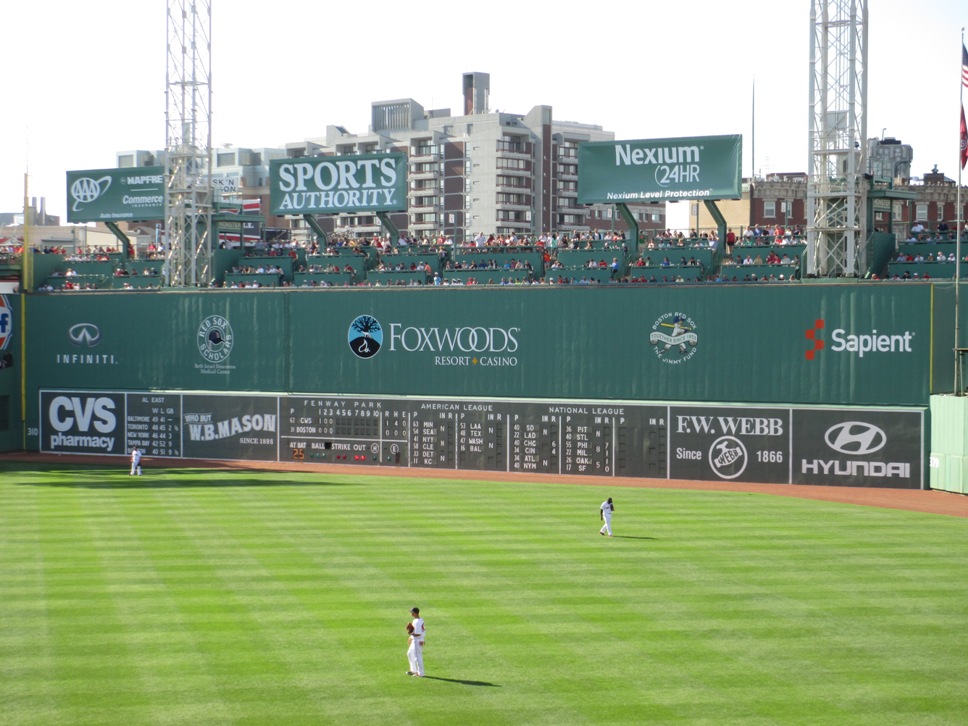
Because we couldn’t build it out onto Lansdowne Street.
Architecture
KURT: The Green Monster says it all…this ballpark is not only built on one city block, but that block is shaped such that if we put a normal fence in left field, bloops just barely out of the infield could become home runs.
The big wall in left field is the centerpiece of a design so asymmetrical that a team would be accused of ridiculous contrivance of dimensions if they tried it today. Fenway Park almost looks stretched sideways looking at it from overhead.
I’ll never argue that Wrigley has a million unique things about it, but its dimensions aren’t one of them. It was built on one city block too, but the block is square and as such the dimensions don’t give a hitter an advantage on either side of home plate.
Only in Boston could a ballpark be shaped like Fenway…it makes the ballpark one of the more architectural wonders in a city with quite a few of them.
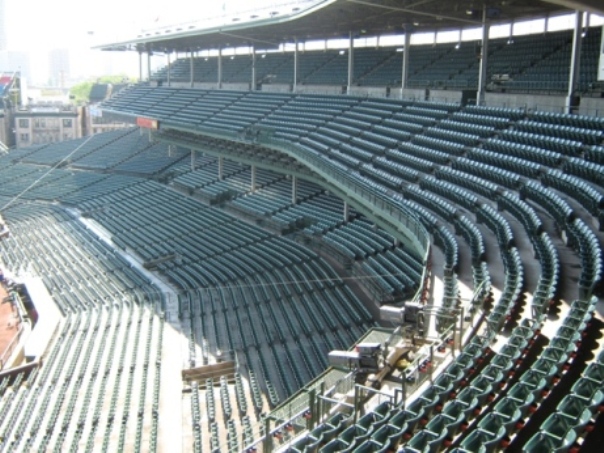
Just build the ballpark in the right spot, and then everyone can see!
JOE: Kurt, it’s interesting that you bring up both Fenway’s shape and its dimensions, because I believe both are drawbacks.
Regarding the shape of Fenway’s footprint, I would term it “misshapen” more than “stretched sideways.” Like a lot of parks built during the concrete-and-steel era in the first couple of decades of the 20th Century, Fenway’s design evolved over time (but was always limited by the non-square parcel of land).
But this evolution has created a truly undesirable arrangement of seating in Fenway, where a ridiculously large percentage of seats are beyond right center field and, worse, in the right-field corner beyond the foul pole. If you’ve tried to watch a game from a seat in that corner, you’ll know what I mean.
Wrigley, though, evolved in an orderly way that the original architect, Zachary Taylor Davis, could’ve easily envisioned. Hence you have a true upper deck with fantastic views of the field – even from its farthest reaches – and outfield seating that makes sense.
Regarding the dimensions of the two fields, I would again apply the word “misshapen” to Fenway. With foul poles that are 302 feet away in right and, we assume (since the Red Sox discourage anyone from actually measuring it), 310 feet in left, and the silly “triangle” near center, it makes for bizarre dimensions. While I like some originality in outfield dimensions (like the two “wells” in Wrigley’s outfield), the number of oddities in Boston outfield are far too numerous.
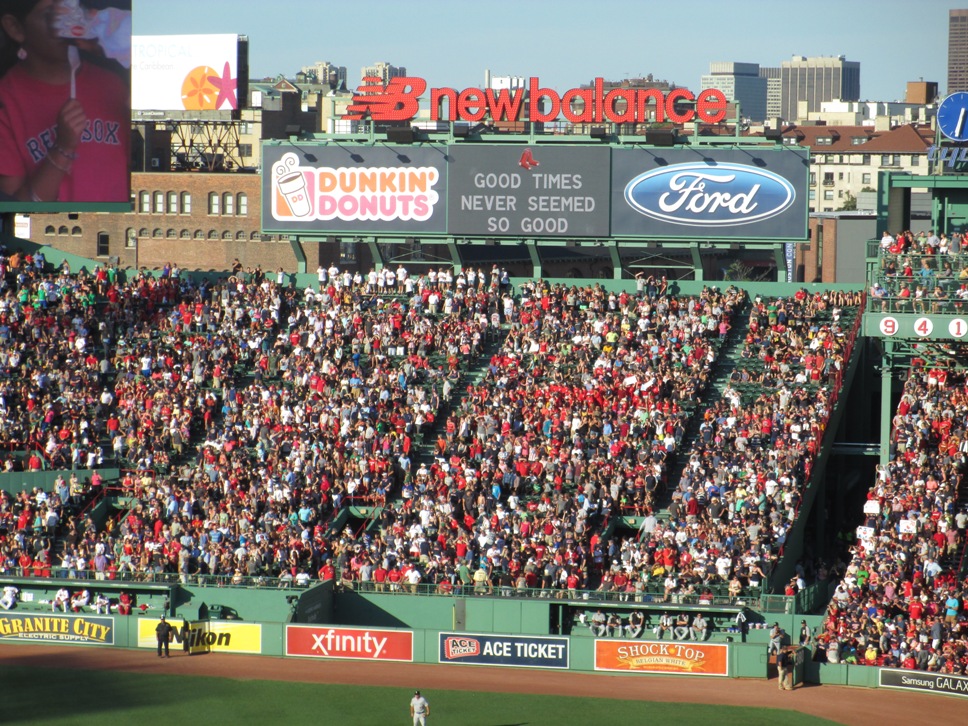
With helpful lyrics on the scoreboard for the two fans that don’t know the words.
Gameday Atmosphere
KURT: When the Red Sox expanded the ballpark, so to speak, into Yawkey Way (now Jersey Street), they created a wonderful pre-game atmosphere for kids of all ages. The old-time band playing, Big League Brian on his stilts, carts selling roasted peanuts and Luis Tiant selling Cuban sandwiches…that’s baseball at its best.
Red Sox and Cubs fans both deserve props for their dedication, and both teams’ fans are raucous and show up in large numbers. But while I’m not knocking anyone’s reason to come to a ballgame, there are fans at Wrigley that are there more for the party than to cheer the Cubs. It’s not just me saying that…I’ve read that a lot. Red Sox fans are rarely accused of this. Everyone in the ballpark lives to hear “Dirty Water” blaring on the PA after a Red Sox victory.
Not to harp on the renovation point again, but the Cubs also did some damage to the gameday atmosphere with the video board and strong arming of businesses like street guys selling programs. The Bucket Bangers, for example, are essential Wrigley…I don’t know if the Cubs were responsible, but I didn’t see or hear them in my last visit. And I missed them.
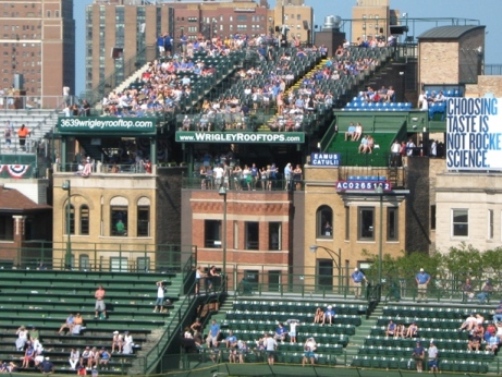
Where else do houses across the street have grandstands?
JOE: While I concede that the Cubs’ current owners made a number of changes based on business decisions rather than aesthetics, it’s still a blast attending a Cubs game. Without the need for the contrived closed-off-street of Yawkey Way, the area around Wrigley is truly alive before and after games.
And there’s something endearing about fans who for generations have come to the Friendly Confines more for the park and the experience than to root for the perpetually losing team. And you can’t say it’s not an “experience” to go to a Cubs home game, win or lose. The front office makes sure of that. The entire season of Wrigley’s 100th Birthday in 2014 was a testament to that.

The Fenway Frank. Essential ballgame sustenance.
Concessions
KURT: Both Wrigley and Fenway are relatively simple in their concessions, at least compared to places like Nationals Park (shawarma) and Progressive Field (Froot loop dogs). When it comes to the basic ballpark food…the basic hot dog…Wrigley doesn’t have the uniqueness of the Fenway Frank. Mushy white bread buns are part of baseball.
Actually, one could argue that there’s a better variety at Wrigley, and there is, at least inside both ballparks. Wrigley does have Gilbert’s sausages and Hot Doug’s dogs, and Giordano’s deep dish pizza is better than Papa Gino’s. But when you add the outside sausage vendors, Fenway has a definite edge…the Inner Beauty hot sauce at the Sausage Connection and the plain sausage and peppers from the Sausage Guy are without peer even inside of Fenway.
Plus Fenway has lobster rolls, so Wrigley featuring Italian beef doesn’t weigh in favor of Wrigley as much…
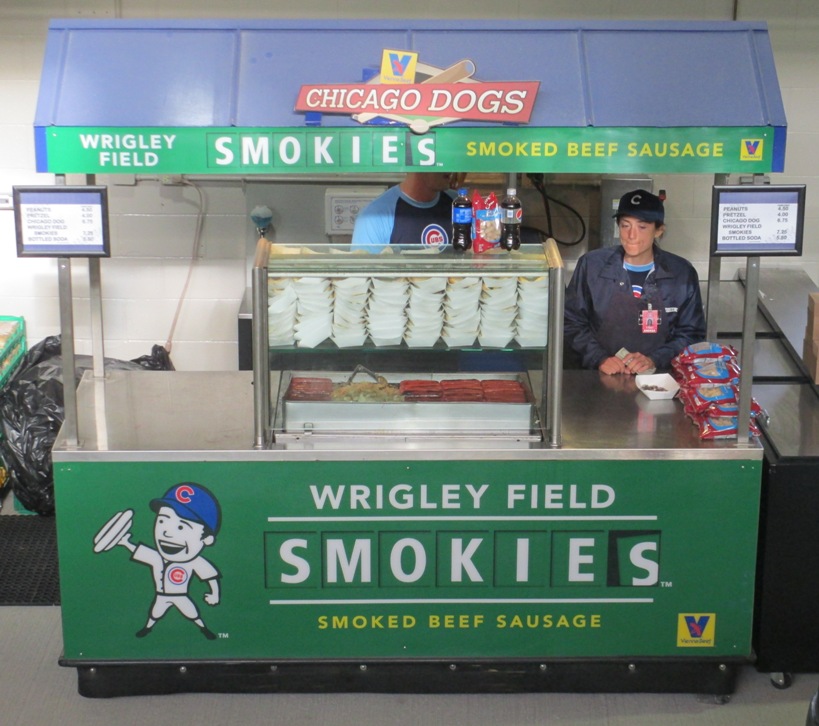
Joe’s got a point about the variety of hot dogs and sausages.
JOE: I’ve always felt the concessions at Fenway were fine, but never in the top ten in the Majors. If you insist, Kurt, on including food sold outside of the ballpark, that does elevate Fenway’s food ranking, but not by much.
I agree that the Giordano’s pizza at Wrigley is better than what’s in Boston, but I think the difference isn’t slight. I think it’s huge. Giordano’s is that good.
The sausages and franks at Wrigley speak for themselves, and far outpace anything of the sort at Fenway. New this year are variations on chicken sausage by Gilbert’s.
And since you’re including food found outside Fenway, I’ll do the same with Wrigley. In the Wrigleyville area, you’ll find perhaps the best corned beef sandwich anywhere at DMK Burger Bar, and next door at the Fish Bar there’ a zesty po-boy that includes both shrimp and crawfish, and a wonderful lobster roll (!). And at Giordano’s sit-down eatery, you can experience their entire array of scrumptious pizzas of varying crust thicknesses, and a savory chicken parm.

Just the words invoke a happy feeling.
Summary
JOE: In 2013, USA TODAY asked me to write an article about each MLB park. They then ran one article per week in their Sports Weekly publication, doing a countdown from number 30 to 1. My top park was Wrigley. I supported that ranking by pointing out the wonderful gameday environment there and the stupendous sense of history.
There’s no doubt that both Fenway and Wrigley are national treasures, and are among America’s most beloved parks – probably the top two on that list. Wrigley, though, edges out Fenway, especially when you consider architecture, surroundings and concessions.
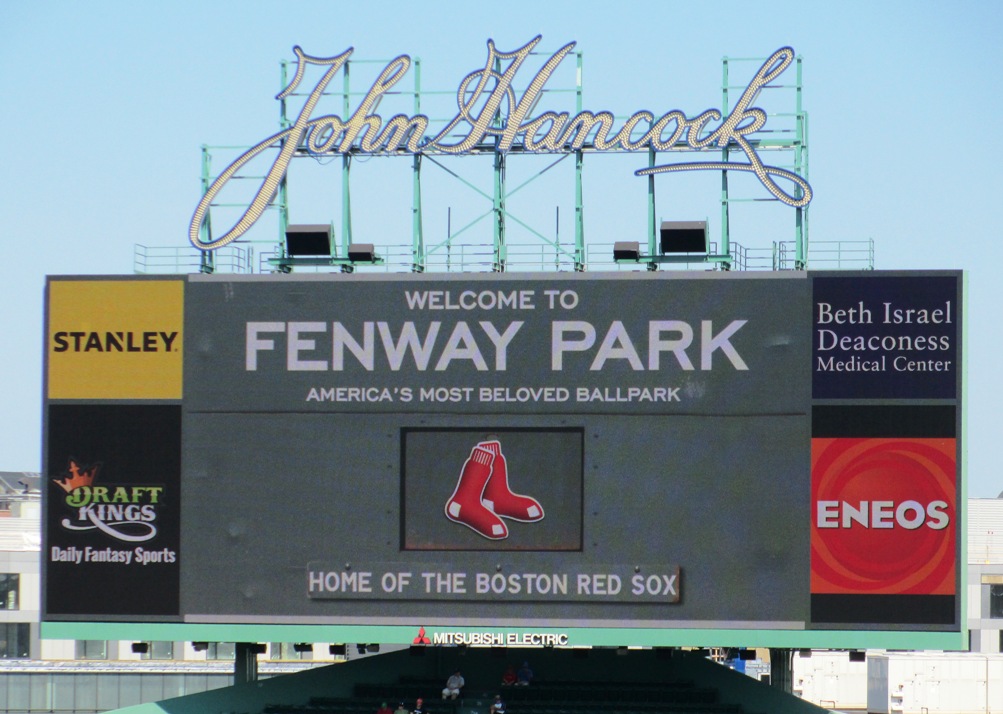
Ditto.
KURT: In the pre-renovation years of both ballparks, I had actually preferred Wrigley to Fenway, largely because there were a lot of pitfalls to mar the experience at Fenway…small concourse space, parking difficulties, and lots of not so great seats. Now that I have researched both ballparks thoroughly, I’ve come to realize that the challenges of Fenway are what makes it great…it’s not a ballpark for amateurs, and it brings out the best in fans.
Wrigley is still a fantastic, iconic venue and as Joe says, a Cubs game is still a blast. It’s just going to take some time for me to get used to the gigantic video boards…and the loss of the rooftops and many of the nearby vendors. There is a stark contrast to how both teams handled their renovations, and it what makes Fenway superior these days, in my totally humble opinion.
Enjoy this article? Check out more about ballparks from Joe and Kurt!
Joe Mock is the writer and photographer for BaseballParks.com, which dates back to the dawn of the Web in 1997. He also writes regularly for USA TODAY Sports. Kurt Smith is the owner and author of Ballpark E-Guides, the highly acclaimed (even by Joe Mock!) detailed fan’s guides to 15 major league ballparks, including Wrigley and Fenway. He is also a staff writer for JerseyMan and BostonMan Magazines.

The Hard Is What Makes It Great – Fenway Park
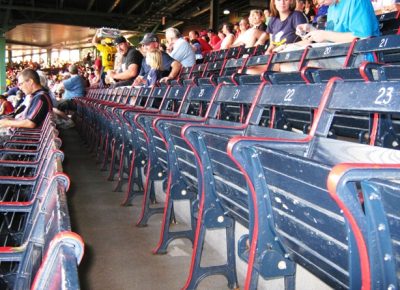
It was a great privilege to contribute this piece about one of my favorite ballparks to the debut issue of BostonMan Magazine, which was released in the fall of 2018. You can read the article on BostonMan’s website, or click here to see the PDF from the magazine.
It wasn’t easy to conceive an angle about Fenway that would be new to Boston sports fans, but every Red Sox fan that read it loved it, which made me very happy. I hope you enjoy it.

Baseball As It Is Meant To Be Watched.
“The Hard Is What Makes It Great.”
The venerable home of the Red Sox has survived not only a relentless ballpark boom, but a new wave of disregard even for relatively new venues. There’s a reason for it that few people outside of Boston understand.
By the time you read this, there may be another World Series about to take place in the ballpark that has sat in Beantown for over a century. The Red Sox have, after all, shown a palpable disregard for supposed curses in the last decade and a half.
When you think about it, it’s no small miracle that Fenway Park is still standing. Lately, you don’t even have to think about it all that much. As ballpark architecture changes at a dizzying rate, Fenway insistently puts its foot down, asserting its unassailable right to continue hosting the world’s greatest game. It remains the immovable object that triumphs over the irresistible force.
Over the last three decades, as municipalities and teams realized there were billions to be made in corporate suites, some romantic and profoundly historic temples of baseball met with the wrecking ball. Most distressingly, even Tiger Stadium, old Yankee Stadium and Comiskey Park were unceremoniously felled by baseball economics. It’s hard to imagine it now, but there indeed was a time when Fenway was in the crosshairs too…and the idea of replacing it had plenty of support.
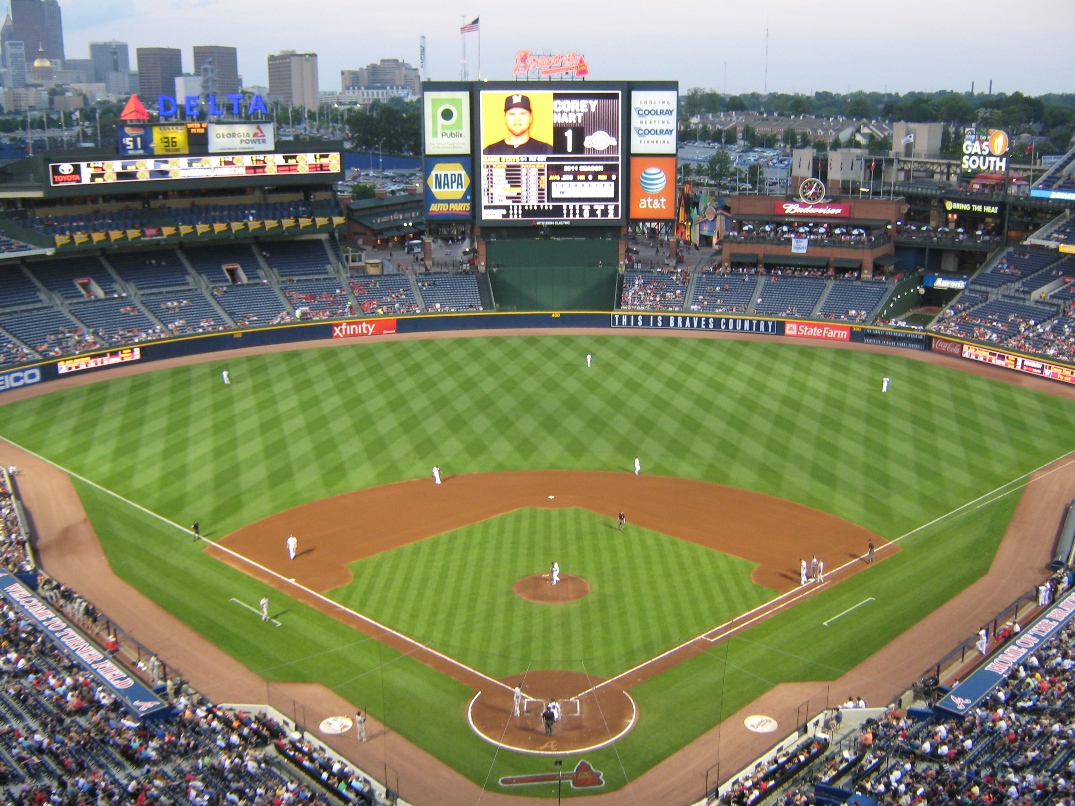
Turner Field in Atlanta. Great ballpark, but you didn’t have long to knock it off your list.
In recent years, the discarding of venues considered shiny by Fenway standards makes it even more remarkable that the ballpark continues to defy its demolition. Teams are now departing from delightful and appealing baseball homes that most fans remember opening. Turner Field in Atlanta lasted just 20 seasons as the home of the Braves, magnificent Globe Life Park in Arlington will be replaced in 2020 after just 26 seasons, and the Diamondbacks have begun the process of exiting Chase Field in Phoenix, another ballpark just 20 seasons old.
Think about that. The Metrodome outlived these outstanding ballparks.
The sports venue boom, one could easily argue, is now completely out of control. For absurd reasons, at least the publicly stated ones, teams are tossing aside perfectly nice baseball settings. The Braves actually cited “traffic” as a problem with Turner Field, as if it’s somehow possible to smoothly shoehorn 20,000 cars into any parking lot on earth in the space of a couple of hours. (Spoiler alert: the traffic at SunTrust Park is far worse. At least Turner Field had a viable public transit option.)
It’s not all that difficult anymore to conceive that Oriole Park at Camden Yards, the venue that started all of this, could itself be threatened with extinction in the not too distant future. As perfect for baseball as Camden is, the Orioles can’t even give away tickets these days…and they’re literally doing just that.
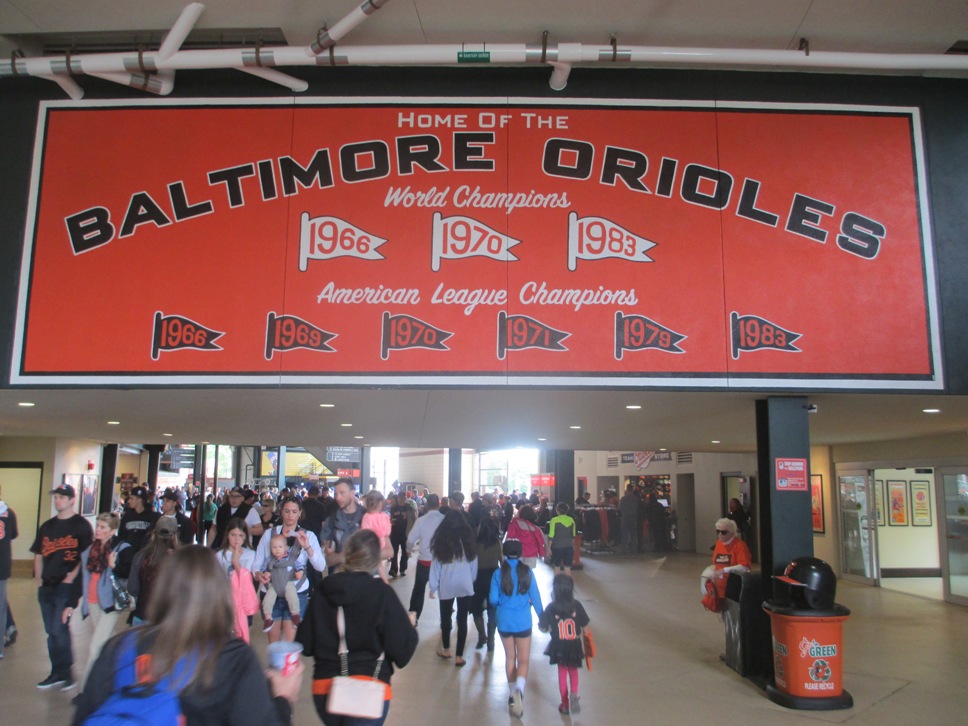
Sure, they haven’t been in the Series since the Reagan Administration. But they revolutionized ballparks at least.
The stunning ballpark creations that arose in response to the phenomenal success of the architectural wonder in Baltimore have been warmly received by spectators. This is especially true in places like Philadelphia, where fans sat in a concrete donut designed for football for 33 seasons. Citizens Bank Park is, by any fathomable measure, a superior venue to Veterans Stadium.
Many of the new ballparks were designed with the charm, or more correctly, the “old time features” of places like Fenway, like neighborhood-necessitated dimensions and distinctive visual landmarks…but without the small seats, grossly insufficient leg room (did people really top out at five-foot-four in 1912?), obstructed views, and fuming in 3 MPH traffic to find exorbitantly priced parking.
With all due respect to Camden Yards, which truly was executed flawlessly, the modern amenities babble is exactly where all of the new venues miss the point.
The home of the Red Sox was never meant to be a place where millennials gather for craft beer tasting, or where patrons sample gourmet sushi from an executive chef, or where fans loudly cheer a mascot race. It’s not that Fenway doesn’t have extras geared to folks that are less than fanatical about baseball. It does. But they’re not emphasized here. There is nowhere near the outreach to “casual fans” at Fenway like there is in nearly every other ballpark in America.
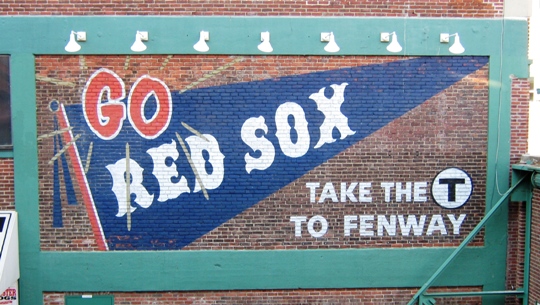
Yes, believe it or not, that packed to the gills train you were just on is the easiest way to get here.
Fenway Park is difficult. It’s the most challenging ballpark in baseball, both to get into and to get to. Most games sell out and require fans to pay an overinflated secondary market rate, seek out skilled haggler scalpers or wait in a long line on game day. Parking is scarce and costly, with cars even placed on top of one another in smaller garages. Trains leading to Kenmore station are stuffed well beyond capacity with sweaty fans.
Choosing the wrong seat at Fenway can lead to the annoying experience of a support pole blocking a portion of the field from view. A fan’s only alternative, at least at that price, is a distant outfield seat in the glaring sun. Oh, and those Grandstand seats? Flimsy wooden chairs, just 15 inches wide, with an inch wide armrest to share with your neighbor. You must be kidding.
For all of the reverence for Fenway Park from baseball fans everywhere, no one would tolerate a newer facility with so many ridiculous flaws. Yet that grand old girl in Boston with the huge green wall in left field remains at the top of so many fans’ bucket list destinations. A ballpark that, on fan experience alone, is utterly inferior to nearly every other venue in professional baseball is filled to capacity every night.
Not even the strikingly beautiful structures in Pittsburgh and San Francisco could ever hope to achieve that. It’s a charm that a less dedicated baseball fan, accustomed to cushioned seats and easy parking, would consider a detriment.
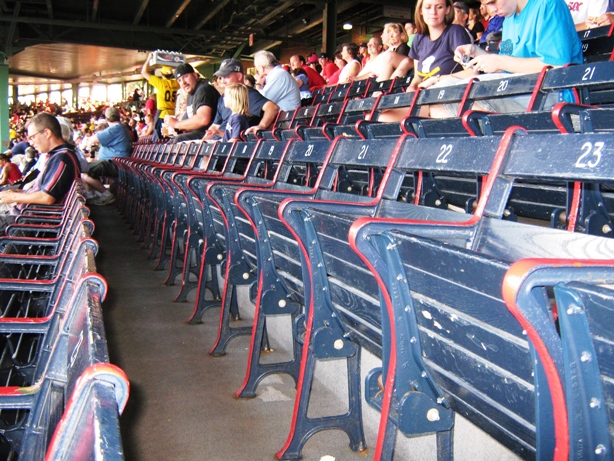
An atmosphere where everyone’s your amigo!
In A League Of Their Own, Tom Hanks has the perfect response to Geena Davis finally succumbing to how difficult the game of baseball is: “It’s supposed to be hard. If it wasn’t hard everyone would do it. The hard is what makes it great.”
This place isn’t for amateurs. Fenway Park is literally designed to weed out the casual fan. If you don’t love Red Sox baseball enough to endure that cramped, stiff seat with no view of right field, you don’t have to go. Not to worry. Someone will take your place…and that someone is exactly the kind of fan baseball needs more of anyway.
Why else on earth would fans tolerate extortionately priced tickets and parking, uncomfortable seats with blocked views, and far too many outfield seats in 2018? Why do Red Sox fans not only put up with all of this, but even sing collectively and enthusiastically about how good times never seemed so good?
Because Red Sox fans get baseball.
They get the incomparable thrill of investing their heart in a baseball team, and seeing a game winning hit bounce off of that green wall.
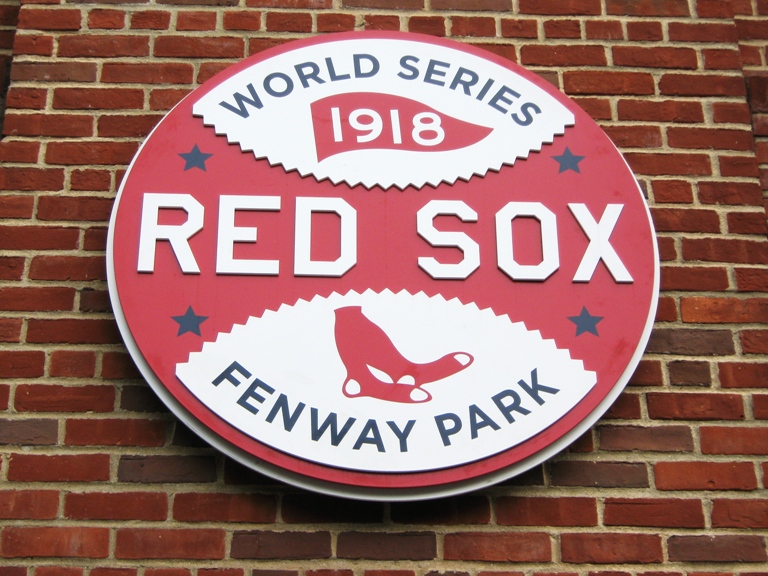
No problem, we’ll wait.
Maybe that simplifies it too much. Try this.
See if you can find someone who was there to witness Ted Williams’ 502-foot smash that landed in a seat now painted red to commemorate the occasion. Actually, that might be difficult, given that it happened in 1946. Maybe you’d have better luck finding someone who was in the ballpark when Carlton Fisk’s home run ball clanged off of the foul pole. That was only in 1975.
Still having trouble? Then try finding someone who was present when Big Papi’s game winner cleared the fence in the 12th, after journeyman first baseman Kevin Millar had duly warned everyone against allowing a Red Sox victory that night. That shouldn’t be impossible.
Found someone? Great. Ask them how much they paid for their ticket, or where they parked, or what the entertainment was between innings.
Chances are good the answers won’t be high on the list of what they remember most about the experience.
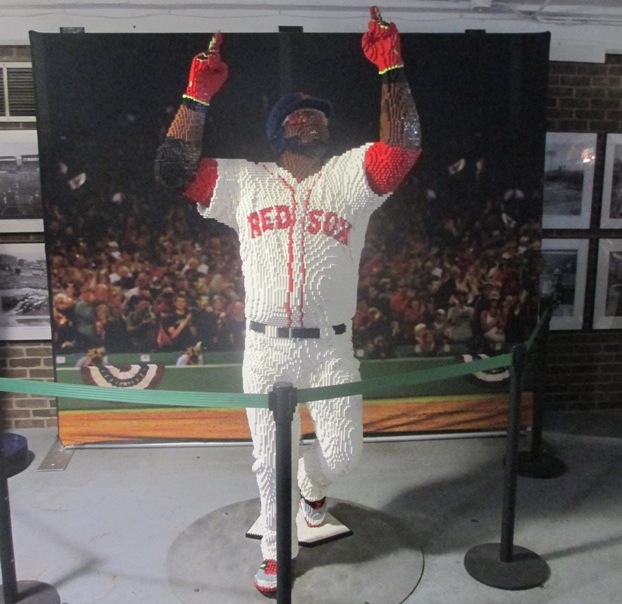
When they make a Lego figure of you, you’ve done ok.
Baseball’s history is a long, ongoing, and endlessly gripping page turner full of otherworldly moments. Nowhere is this more true than in Boston, from the devastating heartbreaks of an 86-year hex to the beyond spectacular glory of 2004. As Big Papi’s hit sailed over the fence and the Sox escaped the jaws of elimination, setting in motion the greatest comeback in sports history, no one in a partially obstructed seat that night would have traded the inconvenience to have missed it.
The Sox fans that overcame the considerable challenges to be inside Fenway Park on those fateful historic days considered it unquestionably worth the aggravation. Just as they continue to do by the millions every summer.
All the obstructions, expensive parking, crowded trains, and no great need for any ballgame sustenance other than a hot dog on mushy white bread. It all makes the point that no retractable roof, amenity-laden facility for baseball could ever make. For all of its flaws, because of its flaws, Fenway Park is absolutely everything a ballpark should be.
An eternal reminder that baseball, Red Sox baseball, is worth it.
Did this post make your day a little bit?
I hope so. If it did, I would really appreciate your support.
When you use this link to shop on Amazon, you’ll help subsidize this great website…at no extra charge to you.
Thanks very much…come back soon!

“Hey, I can’t see the guy in front of me!”
You CAN Avoid (Or At Least Minimize) The Obstructed View
Just because the support poles and their obstructed views keep out less dedicated fans doesn’t mean you have to endure them. There is actually a website called “Precise Seating” dedicated to providing the lowdown on every single seat in Fenway Park. It’s a fantastic resource for Sox fans.
With Precise Seating, you can put in all the information about a seat…section, row, and seat number…and the website will give the seat a 1-10 rating based on various factors: the view, distance from home plate and from the field, even shelter from rain. If there is an obstruction, the site will tell you what percentage of the field is blocked and whether you’ll be unable to see any of the bases or pitcher’s mound.
For example, say you’re looking at Grandstand Section 15, Row 5, Seat 1. Precise Seating will show you the obstruction, and how you won’t be able to see first or second base. They feature an actual photo from the seat, and being five rows from the pole it’s not too terribly bad, but if you have other choices you may want to look for another spot.
Precise Seating is a valuable tool, especially when searching around low numbered rows in the Grandstand. But if you don’t have access to it…say, when you’re patronizing a scalper…just remember a few things:
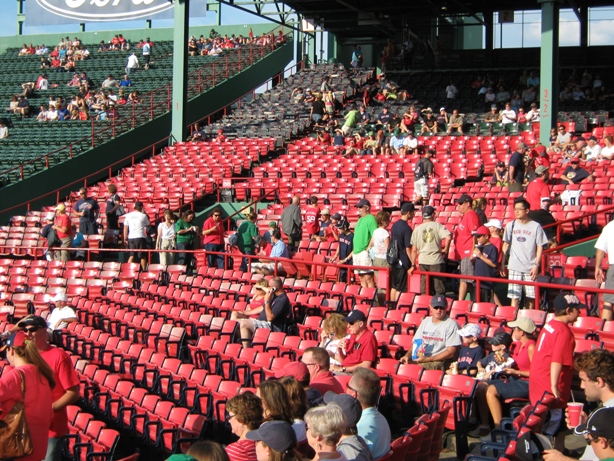
Or you could just sit in front of the poles.
Low rows in the Grandstand are the biggest risk, since the support pole is usually along the first or second row. If you’re going to try it, go for a seat number between 5-12, where you could not only be safe but you may land a great seat for the price. If you’re in a higher row, in most cases the obstruction isn’t too bad if you’re between seats 5-10.
Also, keep in mind that there are support poles in the high rows too, usually in Row 18 or 19. If you go for a seat this high, again, avoid low or high numbered seats. You won’t be able to see scoreboard this high up, incidentally, but there are TVs showing replays of the action.
One last thing: there are no support poles blocking views in Sections 19 and 21, on either side of home plate. Check those first!
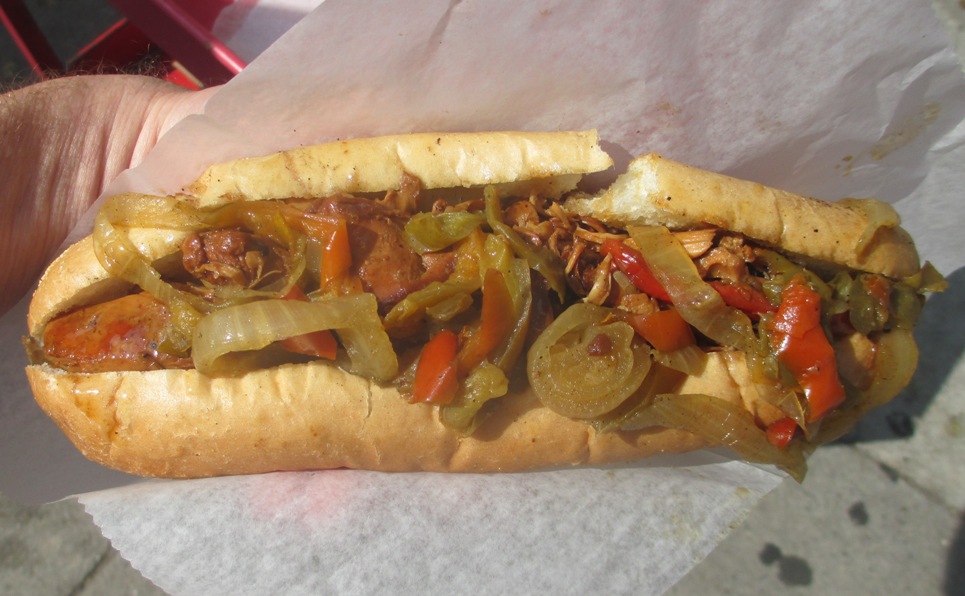
A feast for the eyes at the ballpark. For less!
The Lansdowne Street Sausages
Part of the classic charm of Fenway Park is the sausage hawkers that surround the place…fans can get a decent sized tube of meat on a submarine roll for a few bucks less than what it would cost inside the park. You are indeed allowed to wrap them up and bring them into the game, if you can find some way to keep them warm while waiting in line.
Since most fans arrive at the ballpark from the Kenmore T station, the sausage vendors on Lansdowne Street are the most popular, being the first to emerge into view. They look similar, but there are differences between them. Here are a few fan favorites and what makes them special:
The Sausage Guy – Near the entrance to Cask ’N Flagon tavern is a small blue kiosk run by a gentleman named David Littlefield. The Sausage Guy’s website (yes, he has one) lists some of his stats: two frostbitten fingers from serving in the cold, a torn rotator cuff and three cortisone shots to his left elbow.
The Sausage Guy serves up good-sized sweet Italian sausage sandwiches with onions and peppers. It’s a pretty decent value and you can order the sausage on the website.
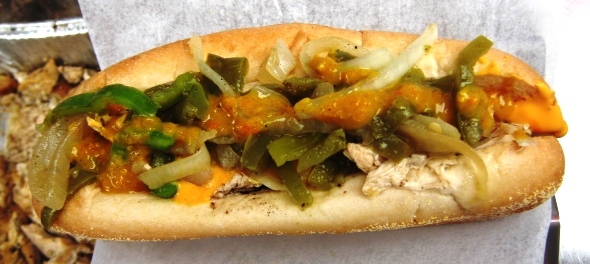
A chicken teriyaki from the Sausage Connection, with “Inner Beauty” hot sauce. Trust me on this one.
The Sausage Connection – The Sausage Connection is the yellow stand located near the Game Day ticket sales line. Not only do they serve up a mean sandwich of sausage, peppers and onions, they offer chicken teriyaki and steak tip sandwiches too.
What makes the Sausage Connection special in a sea of similar looking sausage vendors is their hot sauces, including the popular “Inner Beauty”, a tasty mustard-style sauce that will truly test your ability to handle the heat.
The Original Che-Chi’s – Che-Chi’s is the red stand further down on Lansdowne, and they have similar offerings like sausages, dogs and chicken. Che-Chi’s has their own secret hot sauce, which is a smoky BBQ-style sauce.
Che-Chi’s is also a tad more affordable than the rest; the sandwiches are a buck or two cheaper and they have soda specials.
Remember, you can bring them inside…

This is the easy part.
Alternate Transit Routes
Whether one drives to Fenway Park or uses the T, neither is a particularly pleasant method of transit. Driving to Fenway Park involves lengthy delays and hefty parking charges, but standing in a packed train car isn’t always the most fun ride either.
If you want to try something out of the ordinary, the excellent Fenway Park E-Guide offers some methods of transportation that you might not have considered and their merits:
Commuter Rail – On the Framingham/Worcester Line, Yawkey Station is just 500 feet from the ballpark, near Boston Beer Works. Parking lots this close often cost $50 and up. The ride is far less crowded, the seats are more plentiful and more comfortable, and the MBTA usually runs extra trains on game days.
The best part about this option is that you can book your parking at 100 Clarendon Street through the red Sox website very affordably, hop on the Commuter Rail from nearby Back Bay station, and go one inexpensive stop to the ballpark. Even with two or three people in the car, it’s still far cheaper than Fenway lot prices with just as much walking, and exiting from the garage is a snap afterwards.
Take The “E” Train – Most fans follow the advice on signs at stations that include transfers to the Green Line, the subway line that carries fans to Fenway: use any train except the “E”, which veers in another direction before stopping at Kenmore station.
This leaves the E trains far less crowded, and it’s not a total wash in getting to the ballpark: the Prudential and Symphony stations are maybe a 15-minute walk from Fenway. Many fans park at the Prudential garage to save a few dollars; using the E will spare you the Fenway crowds on the other trains.
And if you’re not up for that walk, you can hire someone to cycle you there in a rickshaw:
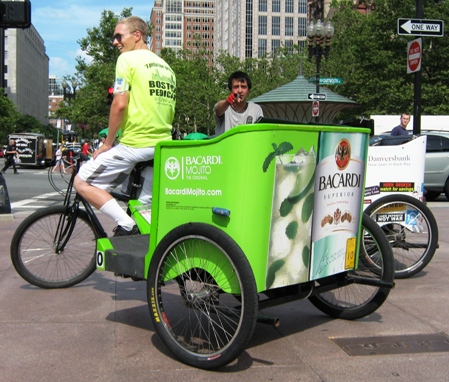
It’s obvious these guys are cool.
Boston Pedicab – The Boston Pedicab rickshaws can often be found around Fenway before and after games. You can find them all around downtown Boston too, especially at the Pru Center where people use them to ride to Sox games. They’re cyclists that pedal you to your destination for free; they subsist entirely on tips. Be generous. It’s a great way to avoid the traffic while enjoying a fine view of the city.
If you can’t find one, you can call Boston Pedicabs and they’ll send one out for you.

